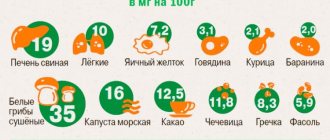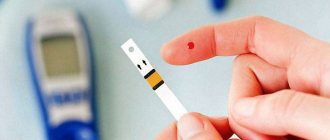A dangerous disease of the endocrine system, diabetes mellitus, does not manifest itself as spontaneously as the flu or food poisoning. A person is inclined to explain the primary signs of poor health by fatigue, poor nutrition “on the go,” and age-related changes in the body. Often, prediabetes and type 2 diabetes are diagnosed in the stage of progressive development only during a routine medical examination or medical examination.
If glucose levels are unstable, the patient is prescribed therapeutic nutrition. To control the disease, you need to know which foods lower blood sugar and which cause hyperglycemia and subsequent complications. The diagnosis of diabetes mellitus involves changes in lifestyle, eating behavior and permanent monitoring of blood sugar levels.
The importance of proper nutrition in diabetes
If you have diabetes of any type and stage of development, you need to monitor your diet every day. A properly selected diet not only prevents the disease from progressing, but also helps to cope with it. For example, in the early stages it is enough to adjust your diet and adhere to the established rules. Then you can be completely cured even without medications.
Diet therapy involves creating a balanced diet based on the optimal amount of essential nutrients (proteins, carbohydrates, fats) and total calories.
In this case, special indicators are also taken into account, for example, bread unit (XE). This is the name for a measure that reflects the total amount of carbohydrates in a particular food product. The mass of bread taken as 20-25 g per unit (in terms of pure carbohydrates is 10-12 g, i.e. half as much).
A person suffering from diabetes should consume a maximum of 25 bread units every day, i.e. no more than 250 g net carbohydrates. The permissible value is often less - it all depends on the type, stage of development of the disease, weight, age, general condition and the presence of physical activity.
Thus, to ensure proper nutrition it is necessary:
- Make a diet according to your doctor's recommendations.
- Develop a food menu for the week.
- Select products by quantity based on calorie content, nutritional value and bread units.
- Follow these rules strictly for a significant period of time.
- Include regular physical activity, which will also help reduce glucose levels.
Gender characteristics
For men
In men, glucose usually decreases after exercise. This happens especially often if you run to the gym immediately after work, forgetting to eat. Therefore, before classes, you must definitely drink the same protein-carbohydrate cocktail. If you look at the glycemic index of sports nutrition, it is quite high. This means that these products will increase sugar and ensure the effectiveness of the workout.
In second place among the reasons is alcohol abuse and, as a result, dehydration of the body. Therefore, the next day, when you have a hangover, you definitely need to eat foods that raise your sugar levels quite significantly.
For women
Hypoglycemia is usually diagnosed in women after 50, during menopause. Therefore, they feel overwhelmed and tired. This is due to hormonal changes in the body. Foods that increase glucose levels can normalize your well-being.
A sharp decrease in glucose is often observed in pregnant women. The same hormones are to blame, as are the expectant mothers themselves, who need to do everything: go to maternity school, buy a stroller, and cook dinner for their husband. If hypoglycemia is diagnosed in women during pregnancy, they are prescribed a special diet, and attacks are stopped with the same sweets (refined sugar or candies).
Examples of a balanced breakfast, lunch and dinner
Menu planning is the main task for a diabetic. We must assume that the maximum calorie content is 1800-2000 kcal per day. Based on this, the composition and quantity of products for each meal are selected.
Breakfast
For tomorrow you can prepare dishes from the following products:
- rye bread (50 g) and butter (5-7 g);
- boiled chicken egg;
- milk glass (200 ml);
- porridge from any cereal (100 g).
Instead of porridge, you can include one of the following dishes:
cottage cheese with a moderate fat content of 4-5% (100 g);
- apple;
- plum;
- peach;
- apricot;
- any citrus (except lemon, lime).
The fruit should be of medium size - the weight in terms of pure pulp is about 100 g. Moreover, it is better to leave the fruit for an afternoon snack as a separate meal. Instead, you can use half a glass of milk (100 ml) for a snack.
Dinner
Lunch is the main meal, so it should be complete. For example, for a proper lunch you can consider the following dishes:
- fish soup or chicken soup (you can use broth with lean meat) 150 ml;
- boiled meat 100 g;
- boiled potatoes 100 g;
- black bread 50 g;
- raw or boiled vegetables 200 g;
- fruit (from those listed above) 100 g.
Dinner
A complete dinner can be prepared using the following products:
- boiled potatoes 100 g;
- any fish (low-fat) 100 g;
- fruits or vegetables 100 g;
- black bread 30 g.
Finally, as a late dinner (1-1.5 hours before bedtime), you can use a glass of low-fat kefir.
Dish bomb
The recipe combines delicious and healthy ingredients. The dish turns out to be low-calorie and satisfying. Cook on an electric grill, or if you don’t have one, use a grill pan.
Seafood with grilled vegetables
Ingredients (for two servings):
- shrimp - 200 g;
- mussels - 200 g;
- squid - 200 g;
- salad mix - 400 g;
- zucchini - 200 g;
- tomatoes −300 g;
- eggplants - 300 g;
- fresh herbs - a bunch;
- green onions - 4 arrows;
- ginger root - 8 g;
- balsamic vinegar - 2 teaspoons.
Step by step
- Cut zucchini, tomatoes, eggplant into thin slices. Grill.
- Clean the squid, shrimp, and rinse the mussels.
- Fry seafood in a frying pan with a minimum amount of oil.
- Add green onions, herbs, and ginger to the seafood.
- Salt, pepper, add prepared vegetables, mix.
- Drizzle with balsamic vinegar and serve.
Foods prohibited for diabetes
If you have diabetes, you need to exclude or significantly limit a number of foods. These include:
- sugar, honey and sweets;
- sweet soda;
- smoked meats;
- fat meat;
- baking;
- margarine;
- fermented milk products (if they are fatty).
If you can’t give up sweets, you can use fruits and vegetables, as well as sugar substitutes, such as xylitol. Moreover, the quantities of these products should also be limited - it is better to consult a doctor first.
What is forbidden to eat
Foods that raise blood sugar are contraindicated:
- sweets, including honey, sugar, jam, certain fruits and berries, sweet pastries and confectionery;
- smoked meats, marinades, spicy, salty dishes;
- lard, lamb fat;
- carbonated drinks;
- alcohol;
- chocolate;
- fast food.
When the patient is aware of which foods reduce blood sugar, it is much easier for him to create his menu. There are also foods that must be strictly limited.
The following list of allowed ingredients in moderate quantities will not cause harm:
- boiled, baked potatoes;
- pasta;
- bread made from premium flour;
- rice and wheat cereals;
- some fruits and berries;
- some special sweets with fructose.
Vegetables, cheeses, with a low glycemic index, normalizing blood sugar should be present along with other permitted foods in the patient’s daily menu.
Forbidden
Can I drink coffee?
The question of drinking coffee for diabetes has not yet received a clear answer. There is an assumption that caffeine improves the sensitivity of body cells to the hormone insulin. Based on this, coffee can not only be drunk if you have diabetes, but it is also necessary. In addition, the drink improves your mood, makes you feel more alert, and stimulates brain activity.
On the other hand, there is also harm:
- increased blood pressure;
- load on the heart muscle;
- powerful diuretic effect (can be quite useful);
- weakening of bone tissue;
- increased acidity levels;
- insomnia.
Thus, diabetic patients can be advised to drink one cup of weak coffee every day. At the same time, you should not put not only sugar in it, but also cream. Cinnamon would be a useful addition as it also helps lower sugar levels.
Glucose norms and deviations in a pregnant woman
Ideally, standard blood sugar levels during the gestational period should not differ from generally accepted reference values. When taking blood on an empty stomach, the sugar concentration should not exceed 5.5 millimol/liter (mmol/L). The lower limit is 3.5 mmol/L.
After eating, your blood sugar levels naturally rise. Food that enters the body is broken down and glucose is formed, which is absorbed into the bloodstream. The maximum value is recorded an hour after eating. Subsequently, sugar levels begin to decrease. Complete stabilization of glycemia occurs after 3 hours.
During pregnancy, a slight increase in blood sugar is allowed. Non-pathological values are:
- from 5.1–5.5 mmol/l – in the blood on an empty stomach;
- up to 8.9 mmol/l – an hour after eating;
- up to 7.8 mmol/l – after 2 hours.
Chronic but minor increases in blood sugar are a sign of prediabetes. A stable shift in values by 1.5 mmol is diagnosed as GDM. Higher blood sugar levels are characteristic of overt diabetes (the second type of disease, which first appears after the child is conceived).
A woman's initial blood test for sugar is taken when she registers for pregnancy. Subsequent studies are carried out as part of mandatory screening (full examination), prescribed once every trimester. If the blood test results are unsatisfactory, sugar control is performed more often. The basis for the diagnosis of prediabetes or GDM is GTT (glucose tolerance testing).
The test is carried out in a laboratory and consists of:
- from a blood test on an empty stomach;
- “glucose load” (the patient is given a provocative portion of an aqueous glucose solution);
- repeated blood sampling an hour later;
- final analysis - in two hours.
Laboratory diagnostic criteria
In addition to GTT, the pregnant woman undergoes a blood test to determine the level of HbA1C (glycosylated hemoglobin), a urine test to detect glucose and ketone bodies (acetone). Manifestations of diabetes and prediabetes in most cases accompany the second half of pregnancy.
Why don't my sugar levels go down?
If the diet is balanced and takes into account prohibited foods, total calories and nutrient content, sugar levels can at least be maintained within acceptable limits. But sometimes even proper nutrition doesn’t really help. This is due to various reasons:
- no or very little physical activity;
- severe, ongoing emotional stress;
- violation of the dosage of administered insulin;
- consequences of a stroke or heart attack.
It is quite possible to control and even reduce blood glucose levels with proper nutrition. But it is important to understand that this is not the only way, so with diabetes you need to adjust your entire lifestyle, not just your diet. In addition, the patient should monitor glucose fluctuations and periodically consult a doctor for advice.
Oatmeal or roti?
Historians who study human eating habits may disagree with me, but I believe that breakfast probably became widespread during the Victorian era.
Before that, in the morning we usually ate the leftovers of yesterday's dinner. Breakfast also stands out because it is the only meal in which people all over the world eat the same thing day after day, year after year, and do not get bored. They even feel lost if they don't eat their usual breakfast one morning; be it two pieces of toast, a boiled egg, oatmeal, or (on another continent) dim sum, roti or saag aloo (dim sum - light snacks in Chinese cuisine, usually served with tea; roti - traditional Indian bread; saag aloo - Indian green dish, potatoes and spices). I remember how difficult it was for me to adjust to curry and vegetables for breakfast when I was working in a hospital in Nairobi as a medical student. Japanese and Korean breakfasts are also completely opposite from Western ones and usually include rice, vegetables, miso soup, pickled vegetables, spicy kimchi or fermented soybeans.
One of the reasons why breakfast may depend on the culture and history of a people, and not be something common to all humanity, is perhaps that the food must somehow be preserved overnight, and then time and effort must be spent on preparing it. in the morning. This means that before the invention of refrigerators, only rich people who had servants could have breakfast. This all changed with the advent of cheap, processed food that can be stored for a long time and is easy to prepare. Kellogg's Corn Flakes became the first major breakfast cereal brand. They were invented in 1894 and were initially considered a very healthy product. Millions of bowls of this cereal are now eaten every day around the world. They are made from refined corn flour and have a very high glycemic index of 81, even higher than potatoes (78).
After removing the nutritious fat-containing parts of the grain, the remaining part is heated in pressure cookers for several hours, and then it is rolled out flat and fried. The result consists mostly of fried starch, which has virtually zero nutritional value. Therefore, various chemicals, including vitamins, are added to corn flakes. Profit margins for breakfast cereals are over 40%; This allows manufacturers to spend approximately 25% of their breakfast revenue on advertising to brainwash children and teenagers and influence the opinions of adults - the general public and nutritionists - about the nutritional value of the cereal. Due to the popularity and profitability of breakfast cereals, there are now 5,000 different brands of breakfast cereals produced in the United States alone.











